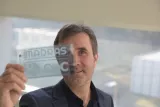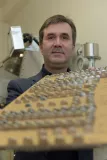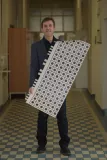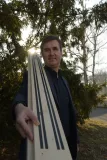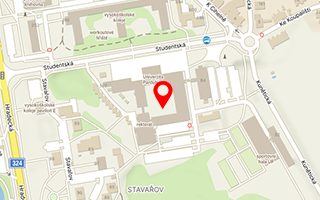Published: 23.06.2022
Within an hour, he can produce hundreds of metres of smart sensors that prevent waste, save batteries or help farmers. Chemist Tomáš Syrový of the Faculty of Chemical Technology started with food and pharmaceuticals.
Today he prints the sensors of the future.
At one of your lectures, you passed around a diaper right at the beginning. Why?
The audience needs to be unlocked at the beginning. I'm trying to create a good atmosphere and at the same time follow the theme, because it's not just any old diaper. It's got a sensor in it that helps you estimate the right time to change it.
All your research revolves around sensors. For example, they're also used in store shelves. What do these sensors indicate?
One beverage company uses them to track the movement of goods in racks and refrigerators. Thanks to our sensors, it has information about how full the shelves are, what needs to be replenished, what time customers most often buy drinks or how different promotions, weather and so on affect customers.
That almost sounds like Big Brother…
From one point of view, it may be a bit like Big Brother, but I think it will serve customers well in the future. It often happens that a husband gets a shopping list from his wife, but when he gets to the store, they don't have the most important thing, so he has to go elsewhere. In the future, these shelf sensors should inform customers where they have the goods and in what quantity. So, the next time my wife writes me a list, the app will select the nearest store that has all the goods I want, and it will also guide me through the store as efficiently as possible by showing me exactly where to find the goods. My idea is that I'll be able to pay for the purchase through the app as well, so I'll save extra time at the checkout.
Doesn't that go against the strategy of the stores that want us to stay in them as long as possible?
It's true that supermarkets want us to walk through as many aisles as possible and pick up as many goods as possible along the way. But I believe that in the future the added value of shops will be to save us time. We won't buy the cheapest stuff, for example, but we will get through the store as easily and quickly as possible. Sensors detecting goods on shelves and pallets are the future not only of shopping but also of supply. It will allow stores to stock efficiently and not need to have such large warehouses; it will be a just-in-time system.
So, we will be able to encounter such sensors in everyday life.
That's right. The sensors will accompany us. They're going to make people's lives easier and protect their health. That is what we are trying to do with so-called food sensors, which are designed to detect the state of food and tell us whether it is still good or whether it is already undergoing some undesirable degradation processes. Some households do not bother to check the product after the expiry date or test it by smell and so on – they just automatically throw it away. So, food that is still in good condition is often thrown away. If there is a simple sensor that tells us that the chicken is still OK after the expiry date because it does not have a certain concentration of biogenic amines or thiols, we can increase the usability of the food and not waste so much.
Will manufacturers be willing to invest more money in smart packaging?
So far, their interest is not that great. However, there is a growing desire in society to eliminate food waste, and legislation is adapting to this, so this is the way forward. And manufacturers will soon be forced to use this packaging. We have already had signals from some that they want to, because they know it is a trend. But the price is, of course, crucial. It is up to us researchers to produce sensors that are functional, safe and also super-cheap.
The need to reduce the amount of packaging materials is also being addressed. And with this, we will add more material to packaging.
Yes, you can think of sensors as just a thin layer that can be printed on top of existing packaging material. Many sensors can also be printed on paper that is biodegradable. So, we add almost nothing to the packaging and do not increase the burden of waste in this respect. In addition, the substances are in almost direct contact with food and must therefore be completely safe.
You say the sensors are printed. How does that actually work?
For example, we use the screen-printing technique to apply sensory layers to various printing materials. The composition of the printing pastes is important. They must have certain properties in order to create suitable sensor parameters that allow sufficiently accurate measurements. Basically, it's similar to printing on T-shirts. The advantage is that the production speed is very high and we can produce maybe tens of thousands of sensors per hour. This allows mass production that is cheap.
What exactly are the sensors in smart packaging made of?
We print them with a functional ink that changes colour from crimson to yellow or from azure to orange depending on the presence of foreign substances or microbial growth. The shade changes are distinctive and therefore easily recognisable to the consumer.
So there is a chemical reaction between the ink and the unwanted substances?
That's right. We're basically making a chemosensor that's sensitive to the presence of various substances, like metabolites that are produced by microbial growth. All sensors are about a reaction with an unwanted chemical compound or a response to some physical variable – like temperature, ultraviolet radiation, and so on.
Let's go back to where the sensors are used. They help farmers, for example.
We are now working with our partners to develop sensors for smart agriculture to measure soil moisture. They can even measure temperature and work at several depths. They are used to analyse the condition of the soil. In greenhouses with automatic irrigation systems, for example, they can control efficient irrigation, and this can reduce water consumption. When they are placed in the fields, they are connected to a communication unit that transmits soil condition data to cloud storage. This can help farmers with post-harvest analysis.
Some of the sensors look like skis. Where exactly can such long boards help?
This sensor will be placed in a cornfield, which is why it is so tall. It is a wooden board on which the sensors are printed, which are also environmentally friendly. The sensor will be stuck into the ground about half a metre deep and a large part of it will be above the surface. In addition, we now have a European patent for printing on wood.
Why should sensors also be in batteries?
It is an area of interest to everyone today. There is a growing interest in electromobility and hybrid solar power systems. I jumped into it myself last summer when we installed a solar power plant with battery storage at home and I started driving an electric car, which is another real-world laboratory and source of a lot of information for me. So, I know from my own experience that with the increasing interest in this issue also comes a lot of questions and concerns about how long batteries actually last.
How can sensors contribute to this?
Using the sensor, we can analyse the internal environment of the battery. Just as a doctor can tell a lot about a patient's health from a blood test, the sensor can tell us what state the battery is in by analysing different parts of it. By knowing its condition, we can extend its life by taking appropriate action to stop some damaging process taking place inside it. We have now also filed an international patent application for this sensor with a foreign partner.
This sounds like good news for future and current electric vehicle owners.
The vision for the future is that due to sensors we will be able to extend the life of the battery, for example in an electric car. We have in our hands an analytical tool, but also tools that will help in the "healing" of batteries, which can extend their life significantly.
How did you get into chemistry in the first place?
I've been drawn to chemistry since I was a kid – even as a child I was interested in firecrackers. My love of explosives made me want to learn more about what goes on inside them and how they work chemically. Until, at one point, it all went wrong. One of the components exploded in my hand and I ended up with a serious injury. Even my high school teacher told me, "Syrový, if anything happens to you, don't come to me." And then one day it happened. As they say, science requires sacrifice (laughs).
I guess you abandoned the explosives after that.
Yes, that's when I got into analytical chemistry, where I joined research in the field of pharmaceuticals. But I was also involved in information technology and graphics, which led me to the Department of Graphic Arts and Photophysics.
Your wife is also your colleague, so she is sympathetic to your work. I heard you wanted to print cookies for Christmas. Did that work out?
It didn't work out in the end, but I'll try it again sometime (laughs). It's funny because I worked in the food industry in Pardubice as a high school student. I graduated as a pastry chef and baker. My wife always tells me I'm a baker, but I don't bake anything at home. This would be the moment when I could prove her wrong. Maybe next Christmas!
doc. Ing. Tomáš Syrový, Ph.D. (1979)
- He works at the Department of Polygraphy and Photophysics, Faculty of Chemical Technology, University of Pardubice, where he focuses on material printing.
- He is the author of a number of patents, utility models, functional samples and proven technologies licensed to him.
- He has been involved in the development of smart incontinence nappies for use in, for example, long-term care facilities.
- He has also developed a bandage sensor that monitors the condition of the wound cover and determines the appropriate time to change the bandage.
- He is a fan of electromobility and solar power generation.
- In his spare time, he enjoys time with his family, travelling, photography, new technologies – which are often intertwined with his research, and reading non-fiction and specialist literature.

